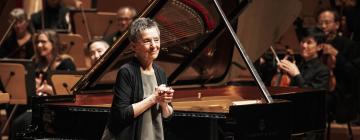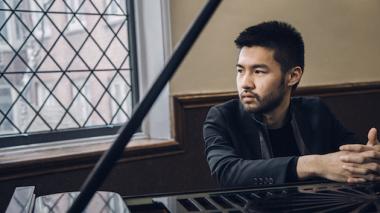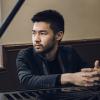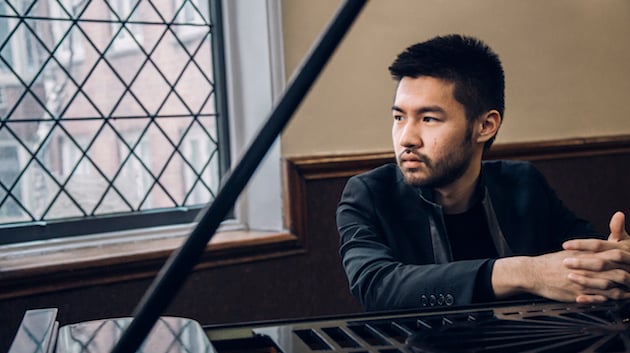
It’s not every musician who makes The New York Times Best Classical Music Performances’ list two years in a row (2017, 2018) — and then earns a slot on the paper’s 2018 Best Dance list, as well. But that’s precisely what pianist/composer Conrad Tao has done. At a mere 24 years old, this Illinois-born phenom has been dazzling audiences since his first recital at age 4. His hefty resume also boasts performances with orchestras around the world, including the New York Philharmonic, the Swedish Radio Symphony, and the Baltimore Symphony, to name a few.
Along the way, Tao has also racked up fistfuls of awards, among them a 2012 prestigious Avery Fisher Grant and eight consecutive ASCAP Morton Gould Young Composer Awards. In addition, in 2011 he was named a Presidential Scholar in the Arts and, in that same year, at age 17, Tao was the only classical artist named by Forbes magazine as one of “30 Under 30” in the music industry.
As a composer, Tao has been called “ferociously talented” by Time Out New York, with compositions commissioned by, among others, the Hong Kong Philharmonic, the Pacific Symphony and the New York Philharmonic. The millennial’s recital and chamber music schedule is packed, as well, with a 2017 solo debut at Lincoln Center and performances this past January with violinist Stefan Jackiw in Vancouver, Canada, and at the 92nd Street Y. This year continues to be a banner one for the nonstop Tao, who bowed with L.A. Opera in David Lang’s the loser in February and performed Schubert and Chopin with the Pacific Symphony in March.
Indeed, no stranger to Southern California, Tao returns to the City of Angels May 18, when he makes his first appearance with Gustavo Dudamel and the Los Angeles Philharmonic. Part of the series, “Dudamel and Beethoven’s Piano Concertos,” the program features Tao performing Beethoven’s Piano Concerto No. 1. I spoke by phone with the polymath on a range of subjects, including his approach to Beethoven, how collaborations open avenues of communication, and his take on classical music as a thriving art form.
You’re filling in for Lang Lang in L.A. on the May 18 concert. What are your thoughts on performing Beethoven’s first piano concerto and how do you keep the work fresh?
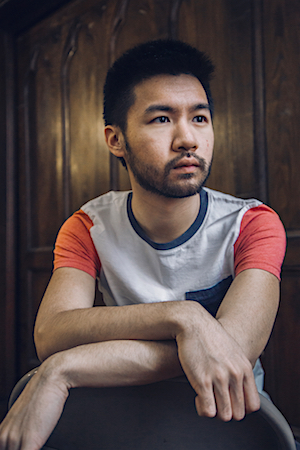
It’s not hard to keep Beethoven fresh, really. It’s good music that allows you to exist as yourself within it. I’ve been looking lately at the holographic manuscripts of the piece, which are freely available on IMSLP [International Music Score Library Project]. There are fabulous resources online for Beethoven scores and it’s an incredible thing to be able to do. I keep most of my scores on my iPad and looking at that manuscript from 1796 or so, what’s really lovely about that — and there are obvious things that are also exciting — is being able to see what could have been, what he crosses out, the way he revises. So much is scribbled out that you feel like you could almost track Beethoven’s thought process. Of course, that’s a little bit of an illusion, but that’s why making music is exciting. It’s not really possible, when playing music centuries old, to claim a fixed authority. The point of doing your research isn’t being able to say this is how it is. You don’t do the research to get to a perfect place, but to open up new questioning areas. That’s how you keep anything fresh.
That’s also what I would define as good music — music that allows you to find inquisitive new spaces, without having to be willful about it. It’s just not that difficult [because] all of it’s there in a way. Beethoven is so great; it’s a limitless field of possibility. Beethoven is always fresh to me, and I’m always trying to find out what he’s experimenting with in the piece — what are the choices he’s making, the markings he’s using. It’s fresh music because it was written in a spirit of experimentation, curiosity, and personal expression.
Speaking of iPads, whenever I see a soloist using one as a page-turner, I sometimes think, “What if it crashes?”
There’s always a risk, and I’ve had devices crash. It’s very true. But there is plenty of room for failure with a human page-turner, as well. I’ve also page-turned myself. It’s terrifying and one of the hardest things to do, and I have a lot of empathy for people in that position. If I’m using an iPad, if something goes wrong, it’s on me. But it’s no one’s fault. [A performer] could also memorize the piece, and a lot of the times that’s the most enjoyable, because for me, the process of memorizing is more about learning the music and getting it inside of you, so reaching that place is always exciting.
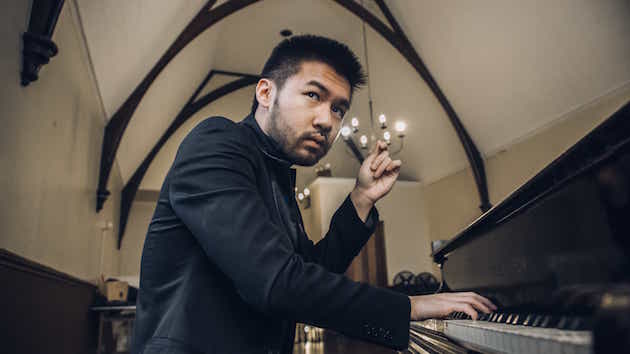
With little rehearsal time, what makes for good chemistry with a conductor — especially when it’s the first time performing together, as you’ll be doing with Dudamel and the LA Phil?
It will be fun to make a debut and it’ll be a quick in and out since it’s part of a festival. But good chemistry is not that different from what you look for in any kind of communication. One hopes that everyone is listening to what’s happening. With a new conductor, it’s also conversing about what we want to do, what we’re curious about. It’s a social thing more than anything else. You want it to feel like a collaboration, and chemistry is a mysterious thing. But in terms of how you try to create conditions for it, it’s just listening to one another with a lot of intention and with curiosity and in good faith — and hopefully, that everyone’s done their homework.
You collaborated with tap dancer/choreographer Caleb Teicher and six dancers on an evening-length work, More Forever, which was part of the Guggenheim Museum’s Works & Process series. It previewed last October and the finished work was performed at the Museum in January. You’ve said that you would like to do more multidisciplinary projects. What was that process like for you?
We’re touring the work now. We spent last year making it over the course of, I think three or four different residency weeks. The first residency involved us all staying in a house together, and that kind of social-creating experience is not as common in the music composition world. And being a dancer is a whole new way of communicating and maybe speaking a slightly different vocabulary, but once you go into the realm of multi-disciplinary work, I found that it’s forced me in so many productive ways to really think about what I was trying to accomplish or explore or communicate. These are not easy things to verbalize or to know, but the process of trying to create a new vocabulary, one that exists in that collaborative space, perhaps uniquely, I can’t compare it to anything else.
It’s not many concert pianists who also have a career as a composer. How do you balance performing with writing?
The reality is that I’m working a lot of the time. I’m now writing pieces and spending a lot of my time doing that. I’m also practicing. Luckily, it’s all fun, and it’s exciting stuff. It doesn’t feel that hard to balance them because they already talk and get along pretty well. One of the nice things about operating in multiple capacities, is it makes the time I do have to just do focus [on] practicing very luxurious. I’m on the road a lot, and part of it also is [that] I’m familiar with the traveling side of it, the rhythm. I’ve been playing in public for quite a long time, and we all develop ways of being, finding ourselves and being happy in it — or hopefully we do, or we try to. You try to go with the flow. I also try not to organize my schedule as though I have more control over it than I do.
From your point of view, it would seem as if classical music is thriving. Do you see a wide age demographic in your audiences?
I feel like I do, and I do think classical music is thriving. It’s an incredibly exciting time to be a musician of any stripe. For any kind of concert musician who likes working, it’s a great time. The resources available for people as they grow up and want to learn different things are unprecedented. The fact that I can find Beethoven’s manuscripts and that centuries’ old, incredibly valuable research material is available, in some form, much more widely these days is fantastic. I worked with teenage composers in recent years, and they’ve all grown up being able to look up tons and tons of music. It’s a really thrilling time to be a young musician and to be a music lover. The quality of playing — more importantly, the curiosity I see in musicians on the scene now that I grew up with — it’s just really gratifying.
As for audiences, I don’t think you should be thinking of people in demographic blocks. There are young people and the way is to not treat them as a flat demographic, that they all like the same thing, because it’s not true. There are always students in the audience, there are a lot of older folks in the audience — that’s who I play for, so it doesn’t really matter. I don’t worry about the health of the art form at all. I think we can talk about the infrastructure, the funding, the collapse of public schools’ arts education, but that has to be accompanied by a larger conversation. None of these things exist as a single problem [and] you can’t put a Band-Aid over them. They’re complicated, large-scale questions.
I feel lucky enough to reach a pretty wide and diverse array of people, and if I have that experience, I can’t be the only one. As a composer, performer, audience member, there’s an enormous group of people that are part of the different communities I’m around. I’m lucky enough to live my life in such a way that I feel I can be surrounded by a lot of love and passion. It’s not that sacred to me. It’s not something you doubt — that’s something I have complete faith in.
